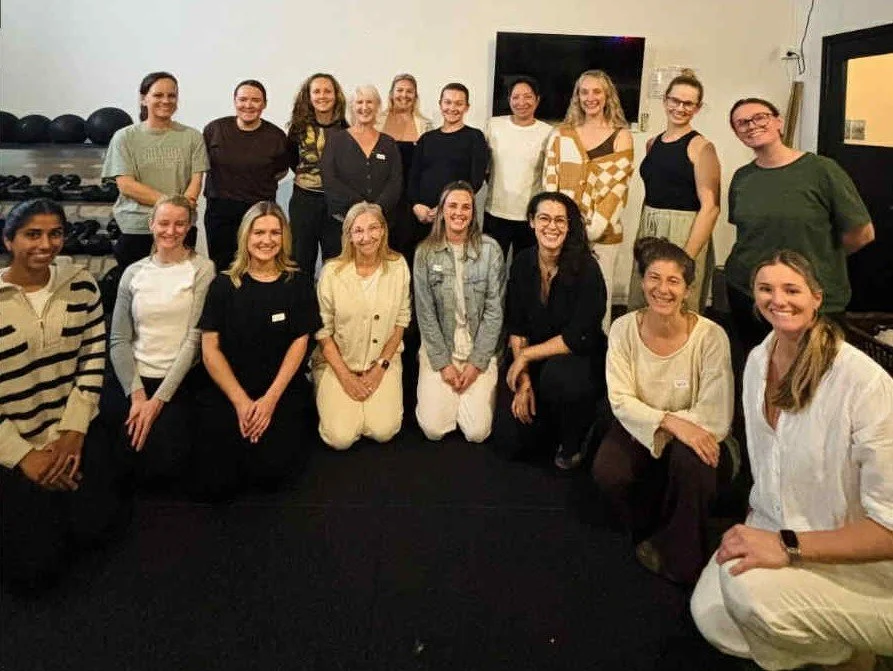Course Recap: The C-Section Release Method
As I’m writing this, I’m on a flight home from Brisbane after attending The C-Section Release Method course ran by Madelaine Longrigg of Body Lane. Maddy is a myotherapist, an amazing, kind and genuine human who was so generous in sharing her skills and knowledge that she’s curated while treating c-section clients over a number of years.
This course was unlike any course I’ve ever attended.. to start with, Maddy opened the day with a breath work and intention setting practice. There were essential oils on hand and dreamy low-fi beats on in the background. Safe to say this is unheard of in typical pelvic floor physiotherapy professional development courses! These grounding elements really set the scene for the day and encouraged a sense of calm and openness to learn and receive.
The next thing that was so great about the context of this course was that I was surrounded by professionals from a really broad range of disciplines: myotherapists, osteopaths, acupuncturists, doulas and pre/postnatal bodyworkers. In fact, I was the only pelvic floor physio there! The Zen in the room was next level!
I learnt SO much from being around these clinicians. What I really took away from being around these wonderful women was the importance of regulating your own nervous system as a practitioner, cultivating a calm environment and holding women through emotional releases which can often happen with the work we do.
We were partnered up with another clinician for the day, and I was lucky to be able to work with a beautiful massage therapist (shoutout Miriam from Inform Physiotherapy in Melbourne, the most genuine and calm soul!)
Through giving and receiving abdominal release techniques together, I learnt the importance of sitting with silence and letting the treatment do the talking. I reflected that I can really be a shocker at feeling a need to fill silences with chatter and questions when treating clients. Sometimes this is great, and I love to chat with my clients, but particularly for this type of work I will definitely be exercising my self restraint muscles and holding space for more silence in future!
In terms of the nitty gritty of the course, we covered the theory, anatomy and contextual factors around c-section surgeries and recovery and then got to work on hands on techniques. These included:
360 breath assessment in standing and lying
Assessing the core and abdominal scars
Myofascial and muscle release techniques of the diaphragm, intercostals, core and hip flexors
Cupping and gua sha to assist in the above
Home based scar release techniques, stretches and rehabilitation
Scar massage through superficial and deep layers
The highlight of my day was being able to receive these techniques on my abdomen and c-section scar and experience the difference they made to my body; particularly the way my scar feels and my ability to breathe deeply and achieve true lateral rib expansion!
Not that I was skeptical before the course, I knew these techniques were effective, but to FEEL them myself really converted me, and now I’ll be preaching about c-section release from the treetops 🤣
So, who can benefit from these techniques? Truly anyone who has had a c-section or other abdominal surgery that has interrupted myofascial front lines and potentially caused adhesions within the tissues. This includes:
Abdominoplasty
Hysterectomy
Laparoscopic surgeries (endo, gall bladder removal, appendectomy, weight loss surgery etc)
Oncology scars
Hernia repair (*no releases directly over mesh!)
Bowel resections
Classic appendectomies
any other abdominal surgery!
These techniques are also effective for women with endometriosis or dysmenorrhea (painful periods) who haven’t had surgery. Facilitating better breathing patterns, reducing tension in the tissues and down regulating the nervous system through calm and purposeful touch is powerful for EVERYONE! 🙌
So, if you want to reconnect to your core, reduce pain, discomfort and pulling in your scar, get rid of the “ick factor” related to your scar, please jump online and book for either a ‘Initial Assessment: Postpartum after Cesarean Birth’ if you are within 2 years postpartum, or for a ‘Initial Assessment: Abdominal Scars’ if your c-section scar is a little older or you have a different type of scar or other abdominal concerns.
Please reach out if you have any questions!
Yours truly,
Mel



